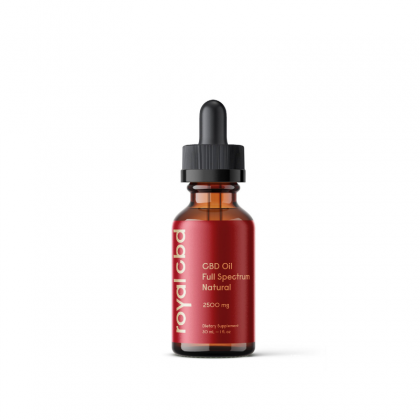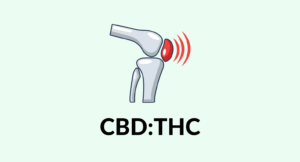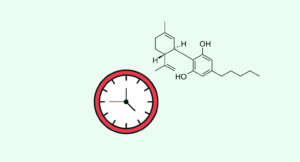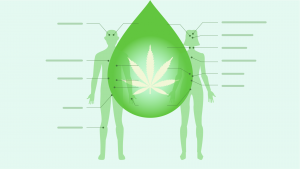| Total CBD: | 500 – 2500 mg |
| Potency: | 16.6 - 83.3 mg/mL |
| Cost per mg CBD: | $0.12 – $0.18 |
| Extract Type: | Full-spectrum |
| THC Content: | <0.3% |
Evidence based
CBD Oil For Pain Relief: Benefits, Dosage, & Side Effects
CBD oil is a popular natural health supplement for managing pain.
But does it really work?
Learn what the evidence suggests, what products to use, and why so many people are swapping their pain meds with CBD oil.
Chronic pain is a problem for millions of people around the world.
Over the last couple of years, CBD oil and other cannabis extracts have shown impressive results in managing pain — without the nasty side effects of prescription painkillers.
People are using CBD products to manage pain from arthritis, multiple sclerosis, fibromyalgia, migraine headaches, amyotrophic lateral sclerosis, nerve damage, PMS, and much more.
Learn how it works and what the research says about it.
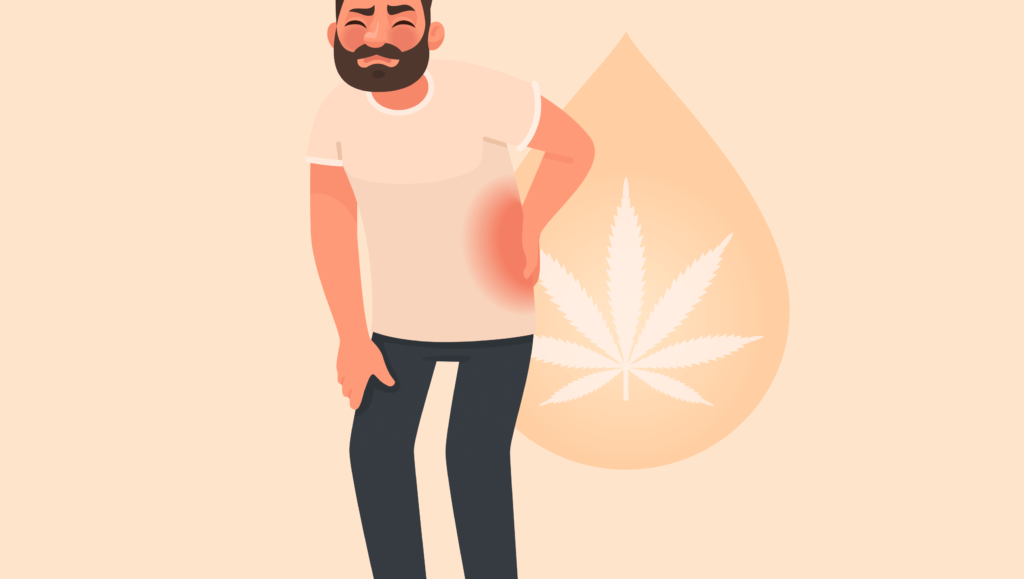
Top Picks: Best CBD Oils For Pain (2022)
- Kiara Naturals Pain-Relief Tincture — Best CBD Pain Formula
- Gold Bee CBD Oil — Best Organic CBD Oil
- Royal CBD Oil — Strongest CBD Oil For Pain
- Eir Health CBD Isolate Oil — Best CBD Isolate Oil For Pain
- Endoca Raw CBD Oil — Raw CBD Oil
- Neurogan CBD Oil — Honorable Mention
- Smile CBD Oil — Honorable Mention
- Five CBD Oil — Honorable Mention
- Verma Farms CBD Oil — Honorable Mention
- Nordic Oil Full-Spectrum CBD Oil — Best CBD Oil For Pain (Europe)
1. Kiara Naturals Pain-Relief Tincture
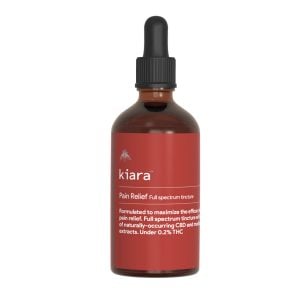
$100.00
Kiara Naturals
Kiara Naturals Pain Relief Tincture
| Total CBD: | 1000 mg |
| Potency: | 10 mg/mL |
| Cost per mg CBD: | $0.10 |
| Extract Type: | Full-Spectrum |
| THC Content: | <0.2% |
Kiara Naturals specializes in making high-grade holistic CBD blends. This means they have a preference for using formulas with other herbs and supplements above and beyond CBD. A well-optimized formula uses ingredients that work synergistically with each other to manage a specific condition.
This pain tincture is a perfect example of an optimized holistic formula for managing chronic pain. It contains a moderate dose of CBD along with powerful painkilling herbs such as corydalis, ginger, California poppy, and zanthoxylum.
It’s important to note that this tincture is made with an alcohol base. If you’re used to CBD oils this one is going to hit pretty hard if you don’t expect it. Tinctures made with alcohol have a higher bioavailability than oil-based tinctures, but they can be hard to palate if you’re not used to them.
2. Gold Bee CBD Oil
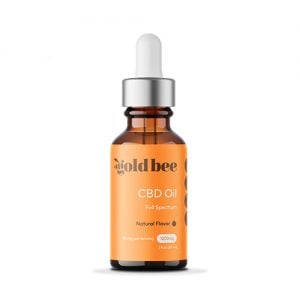
$109.00
Gold Bee
Gold Bee CBD Oil 30 mL
| Total CBD: | 1200 mg |
| Potency: | 40 mg/mL |
| Cost per mg CBD: | $0.09 |
| Extract Type: | Full-Spectrum |
Gold Bee is a small family-owned CBD brand based out of California. Its ticket to fame is the exceptionally high terpene content.
This company focuses on small-batch extractions with the goal of maintaining as much of the naturally occurring terpenes as possible. Large-scale extractions are more efficient for the company but at the cost of damaging a large percentage of the terpenes in the final product.
Terpenes are especially important for pain tinctures. Some terpenes are direct painkillers — others work indirectly by reducing inflammation or improving the bioavailability of CBD and other cannabinoids.
3. Royal CBD Oil (2500 mg)

$49 – $229
Royal CBD
Royal CBD Oil 30 mL
| Total CBD: | 500 – 2500 mg |
| Potency: | 16.6 – 83.3 mg/mL |
| Cost per mg CBD: | $0.12 – $0.18 |
| Extract Type: | Full-spectrum |
| THC Content: | <0.3% |
Royal CBD is one of our favorite CBD oil manufacturers across the board. We’ve found this brand to consistently outperform other products in the same price range in terms of taste, potency, and overall quality.
The highest potency option (2500 mg) is an excellent option for managing chronic pain. It’s a powerful CBD oil made from some of the highest-grade full-spectrum hemp extract money can buy.
4. Eir Health CBD Isolate Oil
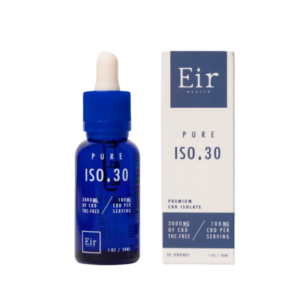
$88.00 – $148.00
EIR Health
Eir Health CBD Isolate Oils 30 mL
| Total CBD: | 1500 – 3000 mg |
| Potency: | 50 – 100 mg/mL |
| Cost per mg CBD: | $0.05 – $0.06 |
| Extract Type: | CBD Isolate |
EIR Health only carries two products — a full-spectrum CBD oil and a CBD isolate oil.
We like both products in this range, but find the ultra-high-potency CBD isolate range to be one of the best when it comes to managing chronic pain.
Isolates are generally considered less ideal for most conditions, but there are some advantages to using these products over full-spectrum extracts.
For people suffering from chronic pain conditions, the main benefit is that CBD isolate is less likely to interact with other medications you may be taking.
Isolates are also better for people who have to take periodic drug tests for work because they’re guaranteed to contain 0% delta 9 THC.
5. Endoca
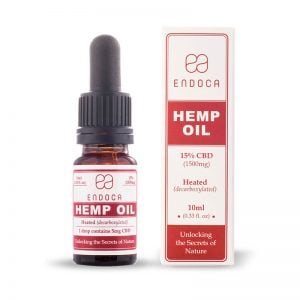
€28.00 – €179.85
Endoca
Endoca CBD Oils 10 mL
| Total CBD: | 300 – 3000 mg |
| Potency : | 30 – 300 mg/mL |
| Cost per mg CBD: | €0.05 – €0.09 |
| Extract Type: | Full-spectrum |
| THC Content: | 0.0% |
What makes Endoca special is that they offer raw CBD oils. This means the extracts have not been decarboxylated and contain a combination of both CBD and CBDa. This is the only company we’ve seen yet that provides both the raw and decarboxylated versions of their oil.
There’s a lot of debate about which extract type is better for pain, and research is still seeking to find the answers.
With that said, a lot of people who have used raw CBD oils report that these extracts are far better for managing inflammatory pain — such as pain from autoimmune conditions. Conversely, the decarboxylated version (standard CBD oil) is reportedly better for nerve pain or pain stemming from acute traumatic injuries or joint degeneration.
6. Neurogan CBD Oil

$29.95 – $269.95
Neurogan
Neurogan CBD Oil 30 – 60 mL
| Total CBD: | 500 – 12,000 mg |
| Potency: | 8.33 – 200 mg/mL |
| Cost per mg: | $0.02 – $0.05 |
| Extract Type: | Full-Spectrum & Broad-Spectrum |
This CBD oil from Neurogan contains a whopping 12,000 mg of CBD per bottle. This is hands down the most CBD we’ve seen inside a bottle of CBD oil to date.
This is a heavy-hitting CBD oil reserved for people with stubborn and persistent pain. A single dropper contains more than 100 mg of CBD.
Despite how strong this stuff is, it’s pretty cheap.
A bottle will run you around $260 which may feel like a lot at first, but when you break down the cost per milligram this is actually one of the most cost-effective oils on the market. Every mg of CBD inside the bottle works out to just 2 cents. A standard 25 mg dose costs around 50 cents, or a dollar for a strong 50 mg dose.
7. Smile CBD Oil
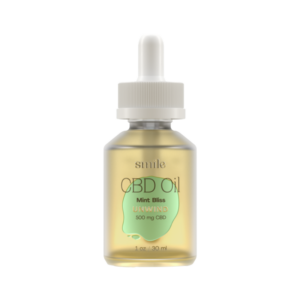
Smile CBD
Smile CBD Oil
| Total CBD: | 500 — 1000 mg |
| Potency: | 16.6 — 33 mg/mL |
| Cost per mg CBD: | $0.08 — $0.06 |
| Extract Type: | Isolate |
| THC Content: | 0% |
Smile CBD carries two versions of its oil — one for use during the day (Energize) and the other for use in the evening (Unwind).
We recommend using both oils together if you’re planning to use CBD all day long. The Energize oil contains vitamin B12 and 5HTP which provide a gentle boost of energy during the day without being too stimulating. The unwind oil contains melatonin, which is a naturally occurring hormone tasked with preparing the mind for sleep.
Indirectly, all three of these added ingredients contribute to the painkilling activity of CBD: vitamin B12 promotes a faster recovery for damaged tissue, 5HTP supports nerve function and may promote faster healing of nerve fibers, and melatonin promotes deeper more restorative sleep.
8. Five CBD Full-Spectrum CBD Oil

Five CBD
Five CBD Full-Spectrum CBD Oil
| Total CBD: | 1500 – 6000 mg |
| Potency: | 50 – 200 mg/ml |
| Cost per mg CBD: | $0.03 – $0.08 |
| Extract type: | Full-spectrum |
| THC Content: | <0.3% |
Five CBD gets its name from its standardized formulations consisting of a 5:1 ratio of CBD to other cannabis derivatives. This ensures each bottle is consistent from one batch to another.
if you’ve used CBD to manage your pain in the past you may have noticed that every so often you’ll get a bottle of oil that just doesn’t hit the same as the ones you’ve tried in the past — even if they’re ordered from the same company. This is because cannabis extraction, especially full-spectrum extracts, highly depend on the cannabinoid ratios of the starting hemp. Different crops may have entirely different cannabinoid ratios which influence the effect profiles of the oils made from them.
Five CBD takes an additional step to ensure all their oils share identical cannabinoid ratios so there shouldn’t be any surprises in how effective (or not effective) your bottle of oil is going to be.
9. Verma Farms CBD Oil
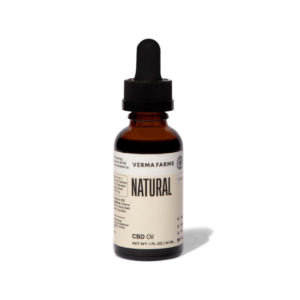
Verma Farms CBD Review
Verma Farms Original CBD Oil
| Total CBD: | 500 mg – 1000 mg |
| Potency: | 16.67 – 33.3 mg/mL |
| Cost per mg CBD: | $0.10 – $0.11 |
| Extract Type: | Broad-spectrum CBD |
If the quality of the branding that went into Verma Farms is any indication of their meticulous attention to detail, I don’t know what is.
This company sells a wide range of CBD oils — the standard range is the best option for general pain and inflammation, but we recommend opting for the highest potency version available — which unfortunately is only 1000 mg.
While this dose is a bit too low for those with severe or persistent pain, it’s likely going to do the trick for moderate or sporadic pain symptoms.
This brand also carries a few more specialty versions of its oils — including a sleep oil, an energy oil, and a focus oil. While none are particularly optimized for managing pain, they’re great options if you want to experience some other benefits with your CBD supplementation as well.
10. Nordic Oil Full-Spectrum CBD Oil
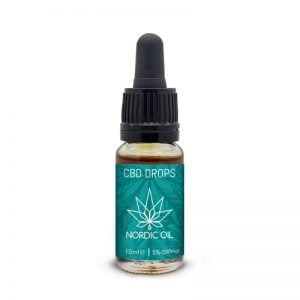
€39.00 – €129.00
Nordic Oil
Nordic Oil Full-Spectrum CBD Oil (Europe) 10 mL
| Total CBD: | 500 – 2000 mg |
| CBD Potency: | 50 – 200 mg/mL |
| Cost per mg CBD: | €0.06 – €0.08 |
| Extract Type: | Full-Spectrum |
| THC Content: | <0.02% |
Nordic Oil has been one of our top European CBD oil manufacturers for three years and running. They have an impressive lineup of top-shelf CBD products to choose from, several of which are well-suited for managing chronic pain,
The best option for general pain relief is the company’s full-spectrum CBD oil, which is available in potencies up to 200 mg per milliliter of oil (exceptionally strong stuff).
You might have noticed that the CBD content of the oil is only 2000, while other options on this list go as high as 12,000. The difference is that Nordic Oil, like many European CBD brands, sells its oil in much smaller, 10 mL bottles. 2000 mg of CBD in a 10 mL bottle makes this the most potency CBD oil on our list.
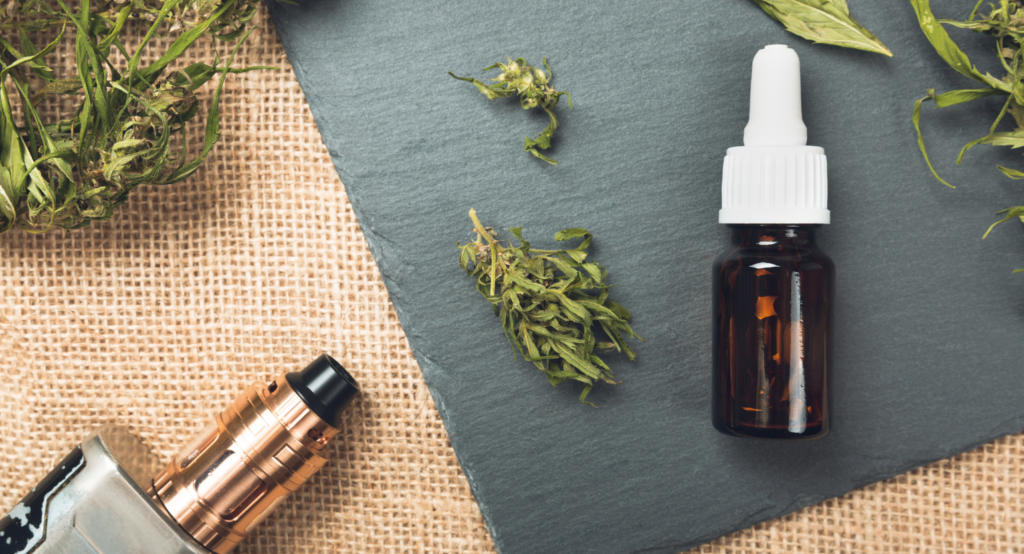
TL,DR: Can CBD Really Help Manage Chronic Pain?
- Blocks pain transmission in the spinal cord and brain — through the vanilloid and opioid pain receptors
- Reduces inflammation — one of the primary causes of pain in the human body
- Alleviates common side-effects of pain — including insomnia, depression, and anxiety
- Reduces the underlying causes of arthritis pain — one of the most common causes of pain
- Regulates nerve cell health & regeneration — which may offer support for pain associated with ALS, multiple sclerosis, PMS, endometriosis, fibromyalgia, and more
- Reduces swelling and inflammation in the muscles after a workout

1. CBD Oil For Arthritis Pain
Arthritis is the leading cause of chronic pain in the developed world. It’s thought to affect as many as 54 million people per year.
There are two different types of arthritis — CBD has been shown to offer support for both:
- Rheumatoid Arthritis — arthritis caused by autoimmune disease (the body’s immune cells attack the joint tissue, causing pain)
- Osteoarthritis —arthritis caused by low-grade inflammation in the joints, leading to a loss of protective cartilage and further inflammation
CBD has been shown to inhibit an enzyme known as lipoxygenase (LOX) [4] — which is a key mediator in the type of inflammation taking place alongside osteoarthritis [5]. By slowing the activity of the LOX enzymes, CBD can slow the progression of inflammation in the joints and lead to a gradual reduction of pain symptoms over time.
Another study found that CBD extract inhibited several key inflammatory mediators involved with rheumatoid arthritis, leading to the production of rheumatoid arthritis synovial fibroblasts (RASF) [6]. RASF formation plays a key role in the underlying process causing rheumatoid arthritis.
By blocking these fibroblasts, CBD may interrupt the underlying cause of the condition.
Related: Check out our Top CBD Oils and Creams & the Best CBD:THC Ratio for Arthritis Pain
2. CBD Oil For Inflammatory Pain
Inflammation is a function of the immune system. It’s your body’s initial response to irritation or damage. Imagine getting a cut or scrape on your skin. Before anything else happens, the area around the scratch or cut becomes red and swollen — this is inflammation taking the initial steps to begin the healing process.
The inflammatory process may occur in response to infection or physical injury (bumps, bruises, fractures) as well as to metabolic, degenerative, and autoimmune conditions.
When you suffer an injury, such as an ankle sprain, the inflammation is particularly noticeable.
But when inflammation occurs internally at lower levels with conditions like irritable bowel syndrome, heart disease, or diabetes the signs can go unnoticed — potentially leading to long-term damage.
The benefits of CBD for inflammation:
- Reduces inflammation
- Reduces swelling and redness
- Prevents autoimmune inflammation
- Widens the blood vessels to reduce inflammation faster
3. CBD Oil For Pain From Neurodegenerative Disorders
“Neurodegenerative disorder” is an umbrella term to describe several conditions involving the gradual destruction of nervous tissue.
The most common cause for neurodegeneration is an autoimmune disease, but other factors include prion diseases, protein or fat metabolism dysfunction, or exposure to toxic substances.
As the neurons become damaged, chronic pain is a common side effect.
CBD primarily helps through its anti-inflammatory and neuroprotective benefits. By alleviating underlying inflammation, CBD oil can help reduce pain and may be able to slow the progression of the disease.
CBD oil has been shown to support the following neurodegenerative disorders:

4. CBD Oil For Muscle Pain (DOMS)
Many people are using CBD oil for muscle recovery between workouts. The active ingredients in CBD oil help relax muscle tension, ease chronic pain, promote faster cell recovery, and prevent inflammation. All of these effects make CBD oil great for use as a post-workout supplement.
One of the most common causes of muscle pain (aside from injuries) is a condition called DOMS (delayed onset muscle soreness). DOMS is caused by micro-tears to the muscles during a workout (a normal part of the process). DOMS pain usually begins about 24 hours after the exercise and can last up to 72 hours.
DOMS can make it difficult to continue exercising, which is why people are using CBD oils to reduce the severity and potentially even prevent DOMS from occurring in the first place.
For best results, combine your CBD oil with a topical CBD pain cream as well.
The benefits of CBD oil for muscle pain include:
- Blocks pain signals from reaching the brain
- Reduces inflammation in the muscles
- Relaxes tight or spastic muscles
- Speeds healing and recovery between workouts
Related: The Best CBD Gummies For Pain.
5. CBD For Neuropathic Pain (Nerve Pain)
This type of pain arises when there’s damage to peripheral nerves, i.e. nerves outside of the spinal cord and brain. A common form of this is a condition called sciatica which causes severe, persistent back pain.
Peripheral nerve damage can result in persistent impairment of nerve function even after the nerve recovers from the original injury [3].
Causes for nerve damage may include:
- Trauma or injury
- Exposure to neurotoxic substances
- Metabolic disorder (such as diabetes or cardiovascular disease)
- Autoimmune disease (such as rheumatoid arthritis)
Similar to chronic inflammatory pain, neuropathic pain can cause hypersensitization to pain signals [3].
The benefits of CBD oil for neuropathic pain:
- Reduces pain transmission through the nerves
- Activates the vanilloid pain receptors
- Protects the nerve cells from further damage
- Defends against oxidative damage
- Supports microglia health in the spinal cord and brain
Related: Best CBD:THC Ratio for Neuropathic Pain.

6. CBD For Chronic Pain
Chronic pain is a fancy word for long-term pain. It can suggest an underlying dysfunction of the tissue involved and can last anywhere from 6 months to years. Chronic pain is common and can be debilitating.
The longer the pain persists, the more it may become resistant to pain management techniques.
A 2008 review article investigated the effects of CBD and THC on chronic pain that was unresponsive to other medications. Researchers in this study concluded that CBD was an excellent pain-management tool for chronic pain, without any adverse side effects [2].
7. CBD For Fibromyalgia Pain
A challenging condition to treat, fibromyalgia involves chronic muscle and joint pain throughout the body, along with fatigue, sleep disturbances, and cognitive impairment.
The benefits of CBD oil for fibromyalgia include:
- Alleviates chronic pain & inflammation
- May support sleep quality
- Fights anxiety & depression
8. CBD for Chemotherapy-Induced Pain
An animal study found CBD may prevent painful hypersensitization of nerve receptors to temperature and pressure, a side effect of chemotherapy medications [10]. The study found that CBD alleviated pain by binding directly to serotonin receptors in the brain.

9. CBD for NSAID-Induced Chronic Pain
NSAIDs are a common class of anti-inflammatories like aspirin, naproxen, and ibuprofen.
Many kidney transplant patients experience chronic pain due to toxic effects to the kidneys of NSAID — which they need to take following surgery.
In a small clinical trial, kidney transplant patients were given doses of 50 mg to 150 mg of CBD twice per day. Results showed partial to complete pain relief in the majority of participants within the first 15 days of the 3-week study [11].

What’s The Dose of CBD Oil For Pain?
The optimal dosage for CBD products can vary from person to person. Use our CBD oil dosage calculator to find the optimal dose for you based on weight and desired strength.
Most of the research investigating the effects of CBD on pain management recommends high doses — usually around 1 – 1.5 mg/kg of bodyweight. For a 150 pound person (68 kg) this works out to somewhere between 60 and 100 mg of CBD per dose.
Therefore, it’s best to use medium or high strength doses when treating pain conditions. For especially difficult to treat pain, even higher doses may be necessary.
It’s also beneficial in these cases to use CBD alongside other pain-management techniques such as physiotherapy, stretching, diet changes, and exercise.
CBD Dosage Calculator
Will CBD Interact With My Pain Medications?
CBD itself is very safe and unlikely to lead to serious side effects or complications.
However, there are some medications that could interact with CBD to result in adverse effects. If you’re using any prescription painkillers or other prescription medications you should always talk to your doctor before taking CBD.
Here are a few common drugs used for managing pain that may interact with CBD or other cannabinoids:
- Buprenorphine (Cizdol & Brixadi)
- Codeine
- Pethidine (Meperidine & Demerol)
- Fentanyl (Abstral & Actiq)
- Hydrocodone (Hysingla ER, Zohydro ER & Hycodan)
- Hydromorphone (Dilaudid)
- Methadone (Methadose & Dolophine)
- Morphine (Kadian & Roxanol)
- Oxycodone (Percodan, Endodan, Roxiprin, Percocet, Endocet, Roxicet & OxyContin)
- Tramadol (Ultram, Ryzolt & ConZip)
- Aspirin (Ascriptin, Entercote)
- Ibuprofen (Motrin, Advil, Nuprin, Caldolor & Neoprofen)
- Celecoxib (Celebrex & Onsenal)
- Naproxen (Aleve)
- Ketorolac (Toradol)
- Etodolac (Ultradol)
- Meloxicam (Mobic)
How to Ask Your Doctor About CBD
Anybody experiencing pain should first schedule a visit to their doctor. Pain is a warning sign that something is wrong, so it’s important to get checked out to learn what’s causing the pain.
Additionally, if you want to give CBD a try but you’re taking other medications or have an underlying condition, it’s important that you speak with your doctor first. Be open and honest with them about all your symptoms, and other medications or illicit drugs you may be taking.
This information is important so your doctor can identify any potential negative drug interactions before they occur.
Learn how to speak to your doctor about CBD.

What CBD Products Are Best For Pain?
Next, the right form of CBD should be used — this could involve CBD topicals, CBD oils, or CBD capsules.
Generally speaking, topicals (CBD pain creams) are best for muscle, joint, and skin-related pain.
Internal forms of CBD (oils, capsules, gummies, vapes), are better for all other forms of pain.
For the fastest pain relief — go for a CBD vape cartridge or CBD vape pen.
For long-lasting pain relief — go for a high-potency CBD oil or transdermal patch.
If you don’t like the taste of CBD oil, go for CBD gummies instead.
The type of CBD oil matters too. Most people find greater relief from full-spectrum CBD oils. If you’re using other medications or subjected to periodic drug tests, go for a broad-spectrum CBD extract or CBD isolate oil instead.
When to Use CBD Topically vs. Internally
| CBD Oils (Oral) | CBD Vapes (Inhalation) | CBD Creams (Topical) | |
| Strengths | • Better for reaching deep muscle tissues • Provides direct pain inhibition on the opioid pain receptors • Offers additional relaxing benefits | • Provides the fastest relief from symptoms • The most convenient form of using CBD | • Delivers CBD directly to the muscle • Best for surface level muscle pain and inflammation • Provides fast relief locally |
| Weaknesses | • Doesn’t provide a strong dose of CBD to the affected area directly • Can be too sedating in high doses for some people | • May not provide enough relief to the muscle itself • Requires you to vape, which may be harmful to health in other ways | • Can be messy • Hard to reach a high dose of CBD to muscles found deeper below the skin |
How Long Does It Take For CBD To Work For Pain?
Once you find a product that matches the type of pain you’re trying to treat and identify an effective dose, the next step is to form a routine around using CBD.
The initial benefits of CBD take effect within 10 minutes for topicals and vape pens, or up to an hour for edible forms of CBD.
The greatest benefit from using CBD for pain can take several days or weeks to manifest. As the damaged or inflamed tissue begins to heal, the pain will start to reduce. It’s important to be consistent with your dose to get these long-term benefits.
Most people will take two or three doses of CBD oils or capsules throughout the day (every 6 hours or so).
For topicals, you may want to apply to the affected area even more frequently (every 3-4 hours).
Learn More: How long does CBD take to work?
Topical CBD Expected Wait Times
| Cause of Muscle Soreness | Expected Onset Time For CBD Pain Creams | Expected Onset Time For CBD Oil |
| Stress & Tension | 15 – 60 minutes | 1 – 3 hours |
| Post-Exercise Recovery | 15 – 60 minutes | 3 – 8 hours |
| Ligament Injury | 15 – 60 minutes | 1 – 3 hours |
| Joint Injury | 15 – 60 minutes | 1 – 3 hours |
| Torn Muscle | 15 – 60 minutes | 1 – 3 hours |
| Muscle Sprain | 15 – 60 minutes | 1 – 3 hours |
| Autoimmune Disorder | 1 – 8 hours | 1 – 2 weeks |
| Compartment Syndrome | 15 – 60 minutes | 1 – 3 hours |
How to Optimize Your Results With Other Lifestyle Changes
For best results, CBD shouldn’t be the only step you’re taking to alleviate pain.
You should seek advice for other forms of pain management and use CBD products merely to supplement these other changes.
This could involve stretching or exercising, visiting a physiotherapist, eliminating potential pain triggers, and eating a well-balanced diet.
This is also why we recommend going for a holistic CBD product rather than just pure CBD. The more steps you take to reduce your pain, the greater the long-term benefit.
What CBD Oil Potency Should I Use For Pain?
When it comes to using CBD for pain and inflammation — not all products are created equal.
There are plenty of CBD products out there, but not all of them are going to provide a strong enough dose of CBD for the desired effects.
If you try and use a low-potency CBD oil for a high dose — you’re going to need to take half the bottle for a single dose. it’s much more cost-effective to order a high-potency oil instead that allows you to get the desired dose with just a few drops, or a few milliliters of oil.
Some people prefer to use a CBD:THC ratio for managing chronic pain — but these products are psychoactive and should be used with caution.
What Potency Should I Buy?
| Product Types | Recommended Minimum Potency |
| CBD Oils | 33 mg/mL |
| CBD Topicals | 8 mg/mL |
| CBD Capsules | 15 mg/mL |
| CBD Vape Oils | 10 mg/mL |
The Benefits of Using Holistic CBD Oils For Pain
As with many of the other uses of CBD, it’s best to find products formulated with other ingredients to make the effects even stronger. We call these “holistic CBD Oils.”
CBD is great, there’s no question about it, but we can make it even better by combining the compound with other beneficial ingredients that can help reduce pain, ease muscle tension, and speed healing.
The best formula will vary a lot depending on the cause of the pain.
Other painkilling ingredients to look for in CBD products:
- Turmeric (Curcuma longa)
- Boswellia (Boswellia serrata)
- Magnesium
- L-Glucosamine
- Kava (Piper methysticum)
- Kratom (Mitragyna speciosa)

Does CBD Oil Have Any Side Effects?
Although CBD has been proven safe and effective, it’s important to know about the potential side effects of CBD. The most common side effect is drowsiness or fatigue, but some people experience effects like nausea, dizziness, or diarrhea.
To avoid side effects, it’s wise to start with a low dose of CBD (around 5 mg) first to see how it affects you before moving on to a full dose.
The most common side effects of CBD include:
Pain 101: What is It? What Causes Pain?
The human body is filled with sensors designed to sense damage — called the nociceptors.
Whenever nociceptors detect damage, they transmit signals to the brain that we perceive as pain.
The system warns us when we’re in danger and reminds us to be careful around injured areas of the body to allow for recovery.
In most cases, pain is a good thing. Without it, we could easily cause irreversible damage to the body without even knowing it.
The problem with pain is that sometimes the signals sent by the nociceptors are unnecessary (no real damage is occurring), excessive (signals are much higher than they need to be), or go on for too long.
It’s under these circumstances that want to block out pain so that we may go about our daily life more comfortably.
While pain can be described according to its qualities, such as sharp or dull, hot or cold, tingling, numb, etc. for treatment purposes pain is often divided into two categories, according to its cause.
Examples of different types of pain:
- Inflammatory pain — pain caused as a side effect of inflammation
- Muscle Pain — pain in the muscles, usually experienced after exercise
- Chronic Pain — pain that persists longer than 4 weeks
- Acute Pain — pain that has been present for 4 weeks or less
- Bone Pain — pain in the bones
- Soft Tissue Pain — pain in soft tissues such as muscles and ligaments
- Nerve Pain — pain originating from nerve damage or dysfunction
- Referred Pain — pain felt in areas away from the site of injury
- Phantom Pain — pain in a limb or organ that has been removed
- Psychosomatic Pain — pain originating from psychological dysfunction
- Breakthrough pain — chronic or acute pain that appears between scheduled medication use
- Cancer pain — pain caused by cancerous tumor formation
- PMS pain — pain from cramping caused during menstruation
The Three Stages of Pain Transmission
Stage 1: Painful Stimulus — The Cause of Pain
This is the cause of the pain. Special receptors in the skin and internal organs are activated whenever there’s damage in the area. They initiate the transmission of the pain signal towards the brain using the peripheral nerves.
Stage 2: Pain Signal Travels to Dorsal Horn in the Spinal Cord
The peripheral nervous system meets the spinal cord — the start of the central nervous system. The pain signal must pass through a region called the dorsal horn. This is the region where compounds such as endorphins and opiate medications are used to limit the intensity of the signal.
Stage 3: Pain Signals are Sent to the Brain
Any pain signals that make it past the dorsal horn make their way to the thalamus in the brain where it’s processed and sent to higher brain regions. It’s these higher brain regions that perceive the pain.

How Neurological Disorders Can Increase Pain
When pain persists and becomes chronic the interpretive mechanisms in your brain can go awry — leading to hypersensitization, amplification of pain messages, and worsening of chronic pain symptoms [6].
Referred to as maladaptive pathological changes [7] — this process can cause physical changes in your brain, evidence of which has been demonstrated in neuroimaging studies showing reduced connectivity between areas of the brain and spinal cord where pain messages are processed [6].
This essentially means the more pain you feel, the easier it is to feel pain again, i.e., the threshold is lowered, so small triggers can lead to inappropriate pain responses.
Impaired nervous system communication reduces your body’s ability to interpret and respond to pain appropriately, resulting in increased activity of the inflammatory cascade. This shows up on laboratory tests as elevated levels of pro-inflammatory signaling molecules and decreased levels of pain-inhibiting molecules like IL-10 [6].
These changes are most evident in neuropathic pain syndromes but have also been found to occur in chronic inflammatory conditions. In these types of conditions, pain can persist even after inflammation has been brought under control [7].
How Anxiety & Depression Make Pain Worse
Pain, anxiety, and depression are intricately intertwined — they often occur together.
While it’s easy to see how chronic inflammatory or neuropathic pain can lead to anxiety and depression, the reverse can also occur. These negative emotional states can cause physiological changes in the brain and body that promote pain.
This makes managing pain much more complicated because now there’s also an emotional aspect to consider.
1. How Anxiety makes Pain Worse
Chronic pain sufferers often become anxious about their condition. Once anxiety sets in it activates the stress response resulting in elevated levels of stress chemicals — notably cortisol and pro-inflammatory cytokines.
Studies show these stress chemicals may cause pain-processing areas of the brain and spinal cord to become hypersensitive to pain messages — a condition known as anxiety-induced hyperalgesia [24].
This essentially means when we’re stressed we experience more inflammation and feel more pain.
2. How Depression Makes Pain Worse
The relationship between depression and chronic pain may be mutually reinforcing.
Chronic pain can cause depression by inhibiting the secretion of dopamine [25], a neurotransmitter responsible for feelings of reward and accomplishment — such as when you perform well in school or at work, or successfully complete a marathon (or a 5K).
Conversely, depression, i.e. low dopamine, has been found to suppress activity in certain areas of the brain that inhibit pain messages, resulting in heightened pain perception [26].
To boil it down, pain causes depression by lowering dopamine levels — and low dopamine causes pain by suppressing areas of the brain responsible for controlling pain.
How CBD May Help With Anxiety & Depression
There’s promising evidence that CBD offers benefits for treating complex pain syndromes involving anxiety and depression.
A large clinical study of psychiatric patients with anxiety and sleep disorders found that anxiety decreased and sleep quality improved significantly within the first month of CBD supplementation [27].
CBD has also been shown to decrease symptoms of depression in laboratory animal studies [28].
However, there’s still much to learn about the complex cause-effect relationship between pain, anxiety, and depression, and CBD may prove helpful for some people, in this regard, but less so for others.

Key Takeaways: Is CBD Effective for Pain?
CBD is an excellent option for people suffering from the pain of various causes.
It’s especially useful for addressing pain brought on by inflammation, autoimmunity, or arthritis.
CBD works at virtually all stages of pain transmission — directly at the site of injury, in the dorsal horn where the opioid receptors are found, and at the opioid and vanilloid receptors in the brain.
Most of the research involving CBD for pain management suggests a dose-dependent effect — meaning that the higher the dose you take, the more it inhibits pain sensations.
For best results, it’s recommended that you find a high-quality CBD oil made with full-spectrum hemp extract and a relatively high potency of active CBD (at least 1000 mg per bottle). Combine CBD use with other pain-reducing activities or supplements for even greater benefit.
Sources Cited in This Article
- Dahlhamer, J., Lucas, J., Zelaya, C., Nahin, R., Mackey, S., DeBar, L., . . . Helmick, C. (2018). Prevalence of Chronic Pain and High-Impact Chronic Pain Among Adults – United States, 2016. MMWR Morb Mortal Wkly Rep, 67(36), 1001-1006. doi:10.15585/mmwr.mm6736a2
- Bruni, N., Della Pepa, C., Oliaro-Bosso, S., Pessione, E., Gastaldi, D., & Dosio, F. (2018). Cannabinoid Delivery Systems for Pain and Inflammation Treatment. Molecules, 23(10). doi:10.3390/molecules23102478
- Xu, Q., & Yaksh, T. L. (2011). A brief comparison of the pathophysiology of inflammatory versus neuropathic pain. Curr Opin Anaesthesiol, 24(4), 400-407. doi:10.1097/ACO.0b013e32834871df
- Kidd, B. A., Wroblewska, A., Boland, M. R., Agudo, J., Merad, M., Tatonetti, N. P., … & Dudley, J. T. (2016). Mapping the effects of drugs on the immune system. Nature biotechnology, 34(1), 47.
- Xiong, W., Cui, T., Cheng, K., Yang, F., Chen, S. R., Willenbring, D., . . . Zhang, L. (2012). Cannabinoids suppress inflammatory and neuropathic pain by targeting alpha3 glycine receptors. J Exp Med, 209(6), 1121-1134. doi:10.1084/jem.20120242
- Meacham, K., Shepherd, A., Mohapatra, D. P., & Haroutounian, S. (2017). Neuropathic Pain: Central vs. Peripheral Mechanisms. Curr Pain Headache Rep, 21(6), 28. doi:10.1007/s11916-017-0629-5
- Rifbjerg-Madsen, S., Christensen, A. W., Christensen, R., Hetland, M. L., Bliddal, H., Kristensen, L. E., . . . Amris, K. (2017). Pain and pain mechanisms in patients with inflammatory arthritis: A Danish nationwide cross-sectional DANBIO registry survey. PLoS One, 12(7), e0180014. doi:10.1371/journal.pone.0180014
- De Gregorio, D., McLaughlin, R. J., Posa, L., Ochoa-Sanchez, R., Enns, J., Lopez-Canul, M., . . . Gobbi, G. (2019). Cannabidiol modulates serotonergic transmission and reverses both allodynia and anxiety-like behavior in a model of neuropathic pain. Pain, 160(1), 136-150. doi:10.1097/j.pain.0000000000001386
- Adela Hilda Onuțu, D. S. D. a. C. P. (2018). Serotonin Reuptake Inhibitors and Their Role in Chronic Pain Management. Retrieved from https://www.intechopen.com/books/serotonin/serotonin-reuptake-inhibitors-and-their-role-in-chronic-pain-management
- Ward, S. J., McAllister, S. D., Kawamura, R., Murase, R., Neelakantan, H., & Walker, E. A. (2014). Cannabidiol inhibits paclitaxel-induced neuropathic pain through 5-HT(1A) receptors without diminishing nervous system function or chemotherapy efficacy. Br J Pharmacol, 171(3), 636-645. doi:10.1111/bph.12439
- Cunetti, L., Manzo, L., Peyraube, R., Arnaiz, J., Curi, L., & Orihuela, S. (2018). Chronic Pain Treatment With Cannabidiol in Kidney Transplant Patients in Uruguay. Transplant Proc, 50(2), 461-464. doi:10.1016/j.transproceed.2017.12.042
- Notcutt, W., Price, M., Miller, R., Newport, S., Phillips, C., Simmons, S., & Sansom, C. (2004). Initial experiences with medicinal extracts of cannabis for chronic pain: results from 34 ‘N of 1’ studies. Anaesthesia, 59(5), 440-452. doi:10.1111/j.1365-2044.2004.03674.x
- Libzon, S., Schleider, L. B., Saban, N., Levit, L., Tamari, Y., Linder, I., . . . Blumkin, L. (2018). Medical Cannabis for Pediatric Moderate to Severe Complex Motor Disorders. J Child Neurol, 33(9), 565-571. doi:10.1177/0883073818773028
- Naftali, T., Mechulam, R., Marii, A., Gabay, G., Stein, A., Bronshtain, M., . . . Konikoff, F. M. (2017). Low-Dose Cannabidiol Is Safe but Not Effective in the Treatment for Crohn’s Disease, a Randomized Controlled Trial. Dig Dis Sci, 62(6), 1615-1620. doi:10.1007/s10620-017-4540-z
- MacCallum, C. A., & Russo, E. B. (2018). Practical considerations in medical cannabis administration and dosing. Eur J Intern Med, 49, 12-19. doi:10.1016/j.ejim.2018.01.004
- Lodzki, M., Godin, B., Rakou, L., Mechoulam, R., Gallily, R., & Touitou, E. (2003). Cannabidiol-transdermal delivery and anti-inflammatory effect in a murine model. J Control Release, 93(3), 377-387. Retrieved from https://www.ncbi.nlm.nih.gov/pubmed/14644587
- Singh, H., Bhushan, S., Arora, R., Buttar, H. S., Arora, S., & Singh, B. (2017). Alternative treatment strategies for neuropathic pain: Role of Indian medicinal plants and compounds of plant origin-A review. Biomedicine & Pharmacotherapy, 92, 634-650.
- Walia, K. S., Khan, E. A., Ko, D. H., Raza, S. S., & Khan, Y. N. (2004). Side effects of antiepileptics—a review. Pain Practice, 4(3), 194-203.
- Lee, G., Grovey, B., Furnish, T., & Wallace, M. (2018). Medical cannabis for neuropathic pain. Current pain and headache reports, 22(1), 8.
- Xiong, W., Cui, T., Cheng, K., Yang, F., Chen, S. R., Willenbring, D., … & Zhang, L. (2012). Cannabinoids suppress inflammatory and neuropathic pain by targeting α3 glycine receptors. Journal of Experimental Medicine, 209(6), 1121-1134.
- King, K. M., Myers, A. M., Soroka‐Monzo, A. J., Tuma, R. F., Tallarida, R. J., Walker, E. A., & Ward, S. J. (2017). Single and combined effects of Δ9‐tetrahydrocannabinol and cannabidiol in a mouse model of chemotherapy‐induced neuropathic pain. British journal of pharmacology, 174(17), 2832-2841.
- Philpott, H. T., O’brien, M., & McDougall, J. J. (2017). Attenuation of early phase inflammation by cannabidiol prevents pain and nerve damage in rat osteoarthritis. Pain, 158(12), 2442.
- Toth, C. C., Jedrzejewski, N. M., Ellis, C. L., & Frey, W. H. (2010). Cannabinoid-mediated modulation of neuropathic pain and microglial accumulation in a model of murine type I diabetic peripheral neuropathic pain. Molecular pain, 6(1), 16.
- Rivat, C., Becker, C., Blugeot, A., Zeau, B., Mauborgne, A., Pohl, M., & Benoliel, J. J. (2010). Chronic stress induces transient spinal neuroinflammation, triggering sensory hypersensitivity and long-lasting anxiety-induced hyperalgesia. Pain, 150(2), 358-368.
- Taylor, A. M., Castonguay, A., Taylor, A. J., Murphy, N. P., Ghogha, A., Cook, C., … & Cahill, C. M. (2015). Microglia disrupt mesolimbic reward circuitry in chronic pain. Journal of Neuroscience, 35(22), 8442-8450.
- Scanlon, G. C., Jain, F. A., Hunter, A. M., Cook, I. A., & Leuchter, A. F. (2017). Neurophysiologic correlates of headache pain in subjects with major depressive disorder. Clinical EEG and neuroscience, 48(3), 159-167.
- Shannon, S., Lewis, N., Lee, H., & Hughes, S. (2019). Cannabidiol in anxiety and sleep: a large case series. The Permanente journal, 23.
- Shbiro, L., Hen-Shoval, D., Hazut, N., Rapps, K., Dar, S., Zalsman, G., … & Shoval, G. (2019). Effects of cannabidiol in males and females in two different rat models of depression. Physiology & behavior, 201, 59-63.
- Lee, J. L., Bertoglio, L. J., Guimarães, F. S., & Stevenson, C. W. (2017). Cannabidiol regulation of emotion and emotional memory processing: relevance for treating anxiety‐related and substance abuse disorders. British journal of pharmacology, 174(19), 3242-3256.
- van de Donk, T., Niesters, M., Kowal, M. A., Olofsen, E., Dahan, A., & van Velzen, M. (2019). An experimental randomized study on the analgesic effects of pharmaceutical-grade cannabis in chronic pain patients with fibromyalgia. Pain, 160(4), 860.
- Rubin, J. J. (2005). Psychosomatic pain: new insights and management strategies. The southern medical journal, 98(11), 1099-1111.
- Russo, E. B. (2008). Cannabinoids in the management of difficult to treat pain. Therapeutics and clinical risk management, 4(1), 245.
- Johnson, J. R., Burnell-Nugent, M., Lossignol, D., Ganae-Motan, E. D., Potts, R., & Fallon, M. T. (2010). Multicenter, double-blind, randomized, placebo-controlled, parallel-group study of the efficacy, safety, and tolerability of THC: CBD extract and THC extract in patients with intractable cancer-related pain. Journal of Pain and symptom management, 39(2), 167-179.
- Russo, E. B., Guy, G. W., & Robson, P. J. (2007). Cannabis, pain, and sleep: lessons from therapeutic clinical trials of Sativex®, a cannabis‐based medicine. Chemistry & biodiversity, 4(8), 1729-1743.
- Ware, M. A., Wang, T., Shapiro, S., Robinson, A., Ducruet, T., Huynh, T., … & Collet, J. P. (2010). Smoked cannabis for chronic neuropathic pain: a randomized controlled trial. Canadian Medical Association Journal, 182(14), E694-E701.
More Health Benefits to Explore
-
Conditions Related to Health Benefits
- CBD For Allergies: Can This Cannabinoid Ease Symptoms?
- Top 10 CBD Oils For Back Pain
- Can CBD Help With Menstrual Cramps?
- CBD for Sciatica: How It Works, Safety, Drug Interactions, & Best Products
- Is CBD a Viable Treatment for Cerebral Palsy?
- CBD Oil For Sleep
- CBD For Psoriasis: Can CBD Help to Alleviate Symptoms?
- Traumatic Brain Injury (TBI)
- Arthritis
- Anxiety & Depression
- Weight Loss
- ADD & ADHD
- Anorexia
- Alzheimer’s Disease & Dementia
- Addiction
- ALS (Amyotrophic Lateral Sclerosis)
- Antibiotic Resistance
- Asthma
- Atherosclerosis
- Autism
- Acne
- Bipolar Disorder
- Pain
- Crohn's Disease & Ulcerative Colitis
- Diabetes
- Epilepsy
- Endocrine Disorders
- Fibromyalgia
- Fatty Liver Disease
- Glaucoma
- Hypertension
- Heart Disease
- Huntington's Disease
- Inflammation
- Irritable Bowel Syndrome (IBS)
- Kidney Disease
- Migraine Headaches
- Muscle Recovery
- Multiple Sclerosis
- Motion Sickness
- Metabolic Syndrome
- Neurodegeneration
- Cancer
- Nausea
- Neuropathic (Nerve) Pain
- Osteoporosis/Bone Health
- Obsessive-Compulsive Disorder (OCD)
- Polycystic Ovarian Syndrome (PCOS)
- PTSD
- Prion/Mad Cow Disease
- Premenstrual Syndrome (PMS)
- Parkinson’s Disease
- Schizophrenia
- Sickle Cell Anemia
- Stroke
-
Conditions Related to Products
- Ranking The Top 13 THC Gummies By Category (Δ8, Δ9, Δ10, HHC, & More)
- Top 10 CBD Oils For Back Pain
- Everything You Need to Know About CBD Sunscreen
- Top 7 CBD Gummies For Sleep & Insomnia
- Top 7 CBD Gummies To Help With Anxiety (2022)
- Best CBD Gummies For Pain (Top-Rated Pain Gummies For 2022)
- Best Hemp Cigarettes (Top 5 Nicotine-Free Smokes)
- Top 5 CBD Lip Balms For 2022
- The Top 7 CBD Face Masks for 2022
- The Best CBD Inhalers For 2022 (& How to Use Them)
- Best Full-Spectrum CBD Vape Juice: What to Look For & How to Use It
- CBD Eye Drops: New Option For Glaucoma?
- CBD Oil For Dogs With Arthritis
- Best CBD Massage Oils In 2022
- Buyer's Guide To The Best CBD Vape Kits In 2022
- CBD Chocolate: Yes, It Exists & It's Just as Divine as it Sounds
- CBD Pre-Rolls & Cigarettes
- Terpene Concentrates
- Best CBD Soaps
- Best CBD Shampoo & Conditioner
- Best CBD Juul Pods
- CBD Isolate Oils
- Full-Spectrum CBD Oils
- Best CBD Lube
- CBD Honey
- CBD Transdermal Patches
- Best Dry Herb Vaporizers
- CBD Oil For Dogs With Epilepsy
- CBD Oil For Dogs With Anxiety
- CBD Oil For Dogs With Cancer
- CBD For Horses
- CBD Chewing Gum
- CBD Pain Cream
- CBD Oil For Cats
- CBD Oil For Dogs
- CBD Hemp Flower
- CBD Suppositories
- Best CBD Gummies for Pain, Sleep & Anxiety Reviewed (2022)
- CBD Teas
- CBD Vape Pens
- CBD Vape Oils
- CBD Coffee
- CBD Drinks & Shots
- CBD Crystals
- CBD Skincare
- Best CBD Oil & Gummies For Kids: Is CBD Safe for Children with Anxiety & ADHD?
- CBD Concentrates
- CBD Bath Bombs
- CBD Capsules
- CBD Sprays
- CBD Dog Treats
-
Conditions Related to Topicals
-
Conditions Related to Oils & Tinctures
-
Conditions Related to Edibles
- Top 7 CBD Gummies To Help With Anxiety (2022)
- Best CBD Gummies For Pain (Top-Rated Pain Gummies For 2022)
- CBD Chocolate: Yes, It Exists & It's Just as Divine as it Sounds
- CBD Honey
- CBD Chewing Gum
- Best CBD Gummies for Pain, Sleep & Anxiety Reviewed (2022)
- CBD Teas
- CBD Coffee
- CBD Drinks & Shots
- CBD Capsules
-
Conditions Related to Gummies
- Ranking The Top 13 THC Gummies By Category (Δ8, Δ9, Δ10, HHC, & More)
- Top 7 CBD Gummies For Sleep & Insomnia
- Top 7 CBD Gummies To Help With Anxiety (2022)
- Best CBD Gummies For Pain (Top-Rated Pain Gummies For 2022)
- Best CBD Gummies for Pain, Sleep & Anxiety Reviewed (2022)
- Best CBD Oil & Gummies For Kids: Is CBD Safe for Children with Anxiety & ADHD?
-
Conditions Related to Hemp Flower
-
-
Conditions Related to Terpenes
-
-
Conditions Related to Cultivation
-
Conditions Related to Concentrates
-
Conditions Related to Delta 8 THC
-
Conditions Related to Delta 9 THC
-
-
-
-
Conditions Related to CBD
- Everything You Need to Know About CBD Sunscreen
- Top 7 CBD Gummies For Sleep & Insomnia
- Top 7 CBD Gummies To Help With Anxiety (2022)
- Best CBD Gummies For Pain (Top-Rated Pain Gummies For 2022)
- Best Hemp Cigarettes (Top 5 Nicotine-Free Smokes)
- Top 5 CBD Lip Balms For 2022
- The Top 7 CBD Face Masks for 2022
- The Best CBD Inhalers For 2022 (& How to Use Them)
- Best Full-Spectrum CBD Vape Juice: What to Look For & How to Use It
- CBD Eye Drops: New Option For Glaucoma?
- CBD Oil For Dogs With Arthritis
- Best CBD Massage Oils In 2022
- Buyer's Guide To The Best CBD Vape Kits In 2022
- CBD Chocolate: Yes, It Exists & It's Just as Divine as it Sounds
- CBD Pre-Rolls & Cigarettes
- Best CBD Soaps
- Best CBD Shampoo & Conditioner
- Best CBD Juul Pods
- CBD Isolate Oils
- Full-Spectrum CBD Oils
- Best CBD Lube
- CBD Honey
- CBD Transdermal Patches
- CBD Oil For Dogs With Epilepsy
- CBD Oil For Dogs With Anxiety
- CBD Oil For Dogs With Cancer
- CBD For Horses
- CBD Chewing Gum
- CBD Pain Cream
- CBD Oil For Cats
- CBD Oil For Dogs
- CBD Hemp Flower
- CBD Suppositories
- Best CBD Gummies for Pain, Sleep & Anxiety Reviewed (2022)
- CBD Teas
- CBD Vape Pens
- CBD Vape Oils
- CBD Coffee
- CBD Drinks & Shots
- CBD Crystals
- CBD Skincare
- Best CBD Oil & Gummies For Kids: Is CBD Safe for Children with Anxiety & ADHD?
- CBD Concentrates
- CBD Bath Bombs
- CBD Capsules
- CBD Sprays
- CBD Dog Treats
-
-
Conditions Related to THC-O
-
-
Conditions Related to Joint Health
-
Conditions Related to Pain Disorders
- Top 10 CBD Oils For Back Pain
- Can CBD Help With Menstrual Cramps?
- CBD for Sciatica: How It Works, Safety, Drug Interactions, & Best Products
- Traumatic Brain Injury (TBI)
- Arthritis
- Pain
- Fibromyalgia
- Glaucoma
- Inflammation
- Kidney Disease
- Migraine Headaches
- Multiple Sclerosis
- Neuropathic (Nerve) Pain
- Premenstrual Syndrome (PMS)
- Sickle Cell Anemia
-
Conditions Related to Autoimmune Disease
-
Conditions Related to Cognitive Health
-
Conditions Related to Metabolic Disorders
-
Conditions Related to Psychological Disorders
-
Conditions Related to Muscles & Bones
-
Conditions Related to Nervous System
- CBD for Sciatica: How It Works, Safety, Drug Interactions, & Best Products
- Is CBD a Viable Treatment for Cerebral Palsy?
- CBD Oil For Sleep
- Traumatic Brain Injury (TBI)
- Anxiety & Depression
- ADD & ADHD
- Anorexia
- Alzheimer’s Disease & Dementia
- Addiction
- ALS (Amyotrophic Lateral Sclerosis)
- Autism
- Bipolar Disorder
- Epilepsy
- Huntington's Disease
- Inflammation
- Migraine Headaches
- Multiple Sclerosis
- Motion Sickness
- Neurodegeneration
- Neuropathic (Nerve) Pain
- Obsessive-Compulsive Disorder (OCD)
- PTSD
- Prion/Mad Cow Disease
- Parkinson’s Disease
- Schizophrenia
-
-
Conditions Related to Reproductive Health
-
Conditions Related to Hormones & Endocrine
-
Conditions Related to Skin Health
-
Conditions Related to Cardiovascular System
-
Conditions Related to Digestive System
-
Conditions Related to Genetic Disorders
-
Conditions Related to For Children


